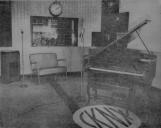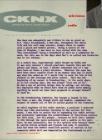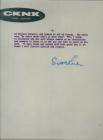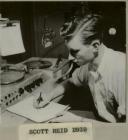1
Switch to Professional...When W.T. "Doc" Cruickshank applied for a professional radio license in 1929, he was bucking the trend. Professional radio stations were located in cities. Some were run by companies like the T. Eaton Company or the Canadian National Railway - not unknown persons from small rural areas. (A Story of CKNX and its People, 2008) The Canadian Department of Transportation's Colonel Steele gave Cruickshank a hard time with his application to operate a commercial station at 1200 kilocycles with the call letters - CKNX. Commercial licenses for towns the size of Wingham were unheard of. Local north Huron area Member of Parliament, George Spottan threatened a filibuster, if Colonel Steele, the man in charge of federal broadcasting, did not grant Doc a license. Finally Steele agreed to give this "tiny farm community" its own radio station.(100 yrs, 22) The application was helped by many people. George Spottan worked hard to get higher power and better frequencies, R.J. Deachman was in large measure responsible for the station getting a commercial license and the present wavelength of 1200 kilocycles with 50 watts of power. (25th Anniversary, 1951) (Carbert essay, 1995)p.2 The station immediately became a western Ontario favourite.
10 B.P. became CKNX, a full commercial station with permission to sell time for advertising purposes. The power was 50 watts and the wave length at 1200 kilocycles. Local businesses began to advertise on the radio and it became a business venture, not a hobby. (25th Anniversary, 1951)
Meaning of "CKNX" ...
"Two call letters are assigned," Doc explained, "and the last two are your choice," He chose NX for clarity on the air because the 10BP was always being confused. Hence the NX in CKNX stands for nothing but clarity. Many other broadcasters used their initials. (LFP-5, 1970)
2
Early logo for 920 CKNX's radio station.1935-1955
920 CKNX, Wingham, Ontario
 Credits:
Credits:North Huron Museum, Wingham, Ontario
3
AdvertisingAccording to Doc, "the idea of the spot advertisement and we found it wasn't a bit hard to sell them, not at the price we were charging - fifty cents! I would sell the ad and write it up and put it on the air and then go out and collect the money for it. I had to take groceries instead of money many times, but I was glad to get anything. Anyway, I survived and eventually the station, now call CKNX, became a vital part of the whole farming community. People started to depend on us for news of the world, farm market reports, and a great deal of their entertainment. In time our equipment improved and so did our programming. I was able to give up my job in the foundry and the other part-time jobs and give all my time to running the station." (McNeil, Voices of Pioneers)
Doc came into the station, years after 1935 and looking over the comparatively large staff and said "You know I remember the day when I didn't need all you guys." With the staff egging him on, Doc pulled out a little book that he'd kept as his log in those early days. It showed that in the morning he went out and went up and down the street selling advertising then came back to the station and read the ads over the air while he performed the rest of the programming duties. "Look there," he said, pointing to the book proudly, "I made two dollars that day." (VS-1, 1976) (50 years, 1976, p.6)
First Commercials
The first commercial went on the air, shortly after Doc was granted his federal license. They cost 50 cents each. CKNX's first month of revenue was $65.50, more than $2.00 a day. (100 yrs, 22)
4
920 CKNX letterhead showing the slogan - "the Ontario Farm Station"1935-1955
920 CKNX, Wingham, Ontario
 Credits:
Credits:North Huron Museum, Wingham, Ontario
5
On the Move ...When Doc Cruickshank obtained a commercial license, more room was required and the station took over the central store of the Shaw Block (199 Josephine Street). In later years, some of the second floor was used for offices and a studio was built in the dining room of the Brunswick Hotel next door to the north (205 Josephine Street). (MM, p.159) Kaye and her husband, Whitney Grose, operated the Brunswick Hotel on Main Street in Wingham, and they shared these facilities with CKNX radio for many, many years. A large picture window opened from the dining room of the Brunswick onto CKNX's studio and their visitors could sit and watch radio programs in progress, with a clear view of the studio and the main control room beyond. Many of the CKNX staffers were regular customers of the Brunswick coffee shop and dining room and it was from these association that we all learned of Kay's prowess as a chef extraordinaire. Marg Brophy capitalized on this talent and Kaye became widely known for her recipes and her pleasant personality. The Brunswick Hotel, like CKNX itself, was burned to the ground and replaced by a supermarket that today lies closed on the main street. (Carbert essay, 1995) p. 9
6
Exterior of CKNX on Josephine Street, Wingham - circa 1940s1940s
Original radio station, Josephine Street, Wingham, Ontario
 Credits:
Credits:North Huron Museum
7
Interior of the original radio station located on Josephine Street, Wingham, Ontario1930s
Original radio station, Josephine Street, Wingham, Ontario
 Credits:
Credits:North Huron Museum, Wingham, Ontario
8
Brunswick Hotel in the winter of 1947 - see the CKNX antennae extending above the hotel's roofWinter of 1947
Brunswick Hotel, Josephine Street, Wingham, Ontario
 Credits:
Credits:North Huron Museum, Wingham, Ontario
9
Doc's Partner - Howard Bedford became a financial partner of W.T. "Doc" Cruickshank when CKNX obtained its professional broadcasting license in 1935. Cruickshank needed funds to expand the station and Bedford invested his time and energy. (CKNX 25th Anniversary, 1951) He was Doc's first commerical director. While Howard worked at CKNX, he met and married Eva Homuth, a receptionist at CKNX.When World War II started Howard Bedford enlisted. He served as Lieutenant Bedford in the Army Signals Corps. At the end of the war, Doc was in a better position to buy out Bedford, who used the money to start his own station, CHVC, located on the Peace Bridge in Niagara Falls.
10
Howard Bedford was W.T. Cruickshank's first partner and commercial manager.1926-1947
920 CKNX, Wingham, Ontario
 Credits:
Credits:North Huron Museum, Wingham, Ontario
11
Story about Scott Reid's experiences working at CKNX.1930-1980
CKNX Radio and Television, Wingham, Ontario
 Credits:
Credits:Wingham Library, Wingham, Ontario
12
Scott Reid's experience working at CKNX1930-1980
CKNX Television & Radio station, Wingham, Ontario
 Credits:
Credits:Wingham Library, Wingham, Ontario
13
Scott Reid began working at CKNX after school and weekends when he was still in high school.1939
Original radio station, Josephine Street, Wingham, Ontario
 Credits:
Credits:North Huron Museum, Wingham, Ontario
14
Technology of Radio ...As the station grew, more technical staff were needed. Scott Reid began as control operator in the days when the majority of the station's gear was home-made equipment. Scott Reid began hanging around the station after high school. He joined CKNX in 1937 as a controlman and announcer, but soon graduated to chief engineer. 'Radio has always been a natural for Scott - even as a youngster he played constantly with crystal sets and performed complicated operations and post mortems on whatever sets were not locked up."(CKNX Almanac, 1942) Just out of the RCAF after a four-year tour of duty, one of his first tasks shortly after he was appointed chief engineer was to design and install new equipment in an entirely revised studio set-up. This task was completed in 1946. Since that time it has been completely re-designed once, and re-wired twice. Scott estimates, there are 17 miles of wire running under the main control room. (OST-22, 1955, p. 5)
Literally every piece of electronic equipment used in the station's service was either built from scratch or remodeled by Scott Reid. Scott Reid's "systems were imaginative and he was far ahead of his time in developing equipment to meet the demands of the growing station. Whether it was remote amplifiers for church broadcasts, sound systems for fall fairs and the Barn Dance or the sophisticated Master Control Room for the studios, Scott was the man who made it all work." (Bob Carbert essay)